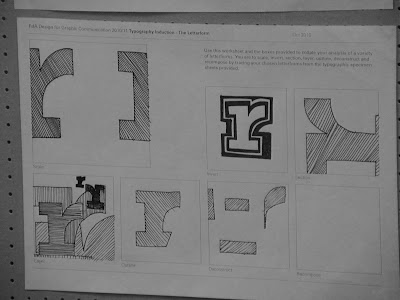\Last tuesday at Lcc we attended a workshop covering the basics of typography and
language.
The session, aims to explore the basic technical language, which visual communicators
must know and commonly use in their everyday practice.Moreover the students were
asked to analyse the role of the typographer and his diverse subject matters.We were
helped with a series ofexercises, mainly about:
Decomposition/Outlines /Repetition in patterns/Enlargement/ of a letter type.

These exercises gives to students the chance to approach the subject
in a simple but effective manner. No particular skills required,
just have fun and be fast. ..coz time is money you know ...

I found that playing with an "R" for 10 minutes can already deliver
unexpected insights.It is kind of amazing how letters can be protagonists
of a struggle to beauty and balance and become to your eyes lines and
shapes that lives of their own. What I mean is, that once you start to play
with them a bit, you are already forgetting about their original meaning
which each of them carries as a symbol, getting into the illustrated side
of the outline shapes and coming then back to their original meaning again.


Robert Bringhurst ( book: The elements of typographic style, version 3.1)
"The typographer's one essential task is to interpret and communicate the text.
Its tone, its tempo, its logical structure, its physical size, all determine the
possibilities of its typographic form.The typographer is to the text as the
theatrical director to the script, or the musician to the score."

The letters of the Western alphabet are built from a system of lines with intricate visual relationships that are nearly invisible. When the text is formed by an appropriate type size, the reader perceive all the letters as they had all the same height, weight and width.
It is of crucial importance to understand that stylistic uniformity discourages distraction during the reading process.


No comments:
Post a Comment